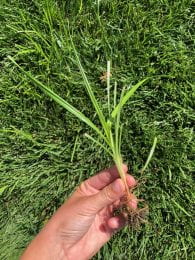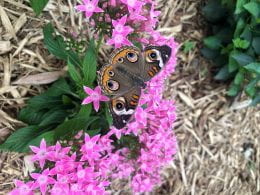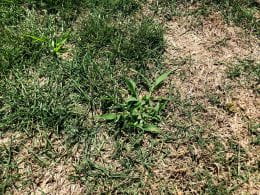Revised by Brooke M. Garcia, original post by Dr. Jared Hoyle
We have been receiving some precipitation recently across the state of Kansas. Even if you have received little rain in your area, you may be seeing yellow nutsedge popping up everywhere. Yellow nutsedge does favor moist soils but it can also grow in well-drained sites.


One of the easiest ways to identify yellow nutsedge is by a couple special features;
- erect
- persistant
- yellow inflorescence
- gradually tapering leaves to a sharp point
- tubers not in chains
- triangular stem
To control yellow nutsedge, if you can get applications out before tuber production then you will see increased control. But beware, yellow nutsedge will continue to grow as long as the environment is favorable for growth, so more than one application may be necessary. If using a herbicide application timing is critical. During mid-summer, yellow nutsedge starts making tubers and if you apply herbicides before tuber production you will get better control. If you wait until the yellow nutsedge is big and starting to make tubers then you will be playing catch-up all year. So sooner is better. Don’t wait for it to get too big.
If using a herbicide application timing is critical. During mid-summer, yellow nutsedge starts making tubers and if you apply herbicides before tuber production you will get better control. If you wait until the yellow nutsedge is big and starting to make tubers then you will be playing catch-up all year. So sooner is better. Don’t wait for it to get too big.
Here are some options for yellow nutsedge control for turfgrass professionals;
- pyrimisulfan (new herbicide that provides yellow nutsedge control)
- sulfentrazone
- halosulfuron
- iodosulfuron
- mesotrione
- bentazon
- triflozysulfuron
- flazasulfuron
- sulfosulfuron
There are many different products out there that contain these active ingredients so just make sure you have an active ingredient that has yellow nutsedge control! Also make sure you check for turfgrass tolerances.
Always remember to READ THE LABEL for the correct rate, turfgrass tolerance, and specific instructions before application.
***Mention of trade names or commercial products in this article is solely for identification purposes and does not imply recommendation or endorsement, nor is criticism implied of similar products not mentioned by Kansas State University.***
Be sure to follow our KSU Turf Facebook page: www.facebook.com/KSUTurf






